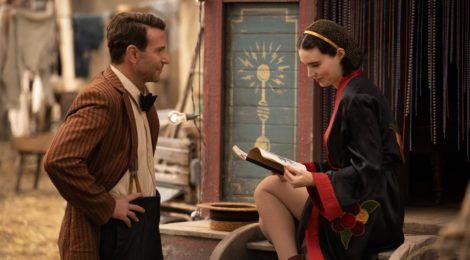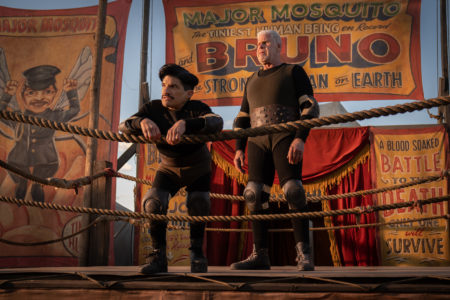Nightmare Alley
Front Row at the Movies by Shirrel Rhoades
[mr_rating_result]Film Noir is “a style or genre of cinematographic film marked by a mood of pessimism, fatalism, and menace. The term was originally applied (by a group of French critics) to American thriller or detective films made in the period 1944 – 54.”
 These films usually feature a cynical outlook combined with a low-key black-and-white visual style grounded in German Expressionistic cinematography. The storylines feature hardboiled crime stories that emerged as a genre during the Great Depression and took roots following World War II.
These films usually feature a cynical outlook combined with a low-key black-and-white visual style grounded in German Expressionistic cinematography. The storylines feature hardboiled crime stories that emerged as a genre during the Great Depression and took roots following World War II.
The term film noir means “dark films.”
Even though the classic period for noir was the ‘40s and ‘50s, some authors still write bleak, dark crime dramas – but today we call it neo-noir, meaning “new darkness.”
I used to own a publishing company called New Pulp Press that specialized in neo-noir mysteries. Some of them would have made the hair on your arm stand up as if you’d touched an electric chord. No sweet dreams here.
My writer friend Mike Dennis loves noir. His books edge on that. He spends much of his time watching old black-and-white films like “Out of the Past” and “The Narrow Margin.” Sometimes he posts reviews of these oldies on Facebook.
I’ll be waiting for his opinion of “Nightmare Alley,” the new neo-noir (is that redundant?) directed by Guillermo del Toro. It’s currently playing in theaters.
Guillermo del Toro Gómez is a Mexican born filmmaker best known for Oscar winners “Pam’s Labyrinth” and “The Shape of Water.” Time magazine included him on its list of the 100 Most Influential People in the World a few years back.
“Nightmare Alley” is based on a 1946 novel by William Lindsay Gresham. The novel had been made into a same-named movie – a classic film noir – in 1947. That cast featured Tyrone Power, Joan Blondell, and Colleen Gray. Having been typecast in romantic and swashbuckler roles, this film was Power’s attempt to break the mold by being cast as an “unsavory lead.”
 Del Toro’s new version starts Bradley Cooper, Cate Blanchette, Toni Collette, Rooney Mara, David Strathairn, Willem Dafoe, Richard Jenkins, and Ron Perlman, among other familiar faces. As The Guardian described it: “Two Oscar winners and six nominees, all bringing their A game.”
Del Toro’s new version starts Bradley Cooper, Cate Blanchette, Toni Collette, Rooney Mara, David Strathairn, Willem Dafoe, Richard Jenkins, and Ron Perlman, among other familiar faces. As The Guardian described it: “Two Oscar winners and six nominees, all bringing their A game.”
The plots are pretty much the same: An ambitious con-man (Cooper in the new film) working with a carnival forces his way into a mind-reader act (Colette and Strathairn), hooks up with a younger woman (Mara), forges an alliance with an unscrupulous psychiatrist (Blanchett), then gets scammed himself.
Nobody wins.
Some critics prefer the original 1947 version.
But practically all of them pay tribute to Del Toro’s “direction, visual style, cinematography, musical score, costume design, production design, and the performances of Cooper and Blanchett.”
This was a passion project for Guillermo del Toro, a self-declared cineaste. He’s always been attracted to the dark, the lurid, the grotesque, so it’s surprising he’s never attempted a neo-noir before.
The film is a tad too long at 140 minutes for what should have been “a tight murky little thriller.” It’s divided into two halves: the carny world and the city world. However, in the end the plot takes us full circle. (I don’t have to yell spoiler alert if you’ve seen the original film.)
Even so, this “curious misfire” is as entertaining as a stroll along the sawdust corridors of a carnival sideshow, glittery, dazzling, over-hyped, populated with freaks and geeks, allowing you to rub elbows with con men (and women) who are looking to pick your pocket.
Step right up, folks! Don’t be shy! Be prepared to witness the whimsical, the outlandish, the macabre, and the beautiful! It’s all right here in “Nightmare Alley.”
Email Shirrel: srhoades@aol.com


Ratings & Comments
[mr_rating_form]